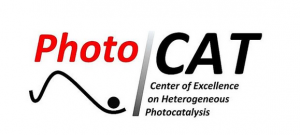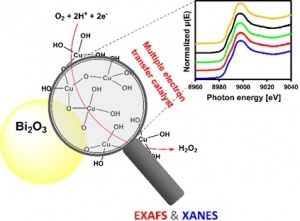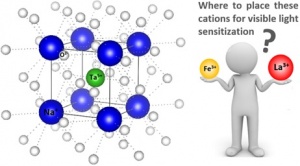 About
About
Indonesia is a tropical country blessed with sunlight all year round. Therefore, any technologies involving sunlight as the energy source are relevant to Indonesia. One of such promising technologies is photocatalysis. Photocatalysis is the acceleration of a photoreaction in the presence of a catalyst; the so-called artificial photosynthesis. Based on this rationale, PhotoCAT – The Center of Excellence on Heterogeneous Photocatalyst Materials is established by Dr. Hanggara Sudrajat in the Department of Chemical Engineering, Universitas Jember to perform innovative researches on heterogeneous photocatalysis for solar energy conversion. The ultimate goal of PhotoCAT is to become the core laboratory for photocatalysis research in the region. Research standards at PhotoCAT are internationally recognized to be at the cutting edge of scientific discovery. PhotoCAT is extensively strengthening its research capacity, and hence is always pleased to establish new research collaboration with both international and domestic groups working on photocatalysis and related topics.
Research Topics
The main topic of PhotoCAT includes the development of inorganic hybrid nanostructures for making efficient use of light energy to evolve hydrogen and to reduce carbon dioxide, as well as for environmental purification to photomineralize refractory organic compounds via heterogeneous photocatalysis. A diverse range of metal oxides and carbon-based materials intended for artificial photosynthesis have been developed by PhotoCAT thus far. Synchrotron-based techniques, such as XANES, EXAFS, soft-XAS, XPS, XFH, and UPS, are involved for the characterization (Figs. 1 and 2). Use of such state of the art techniques leads to new, fundamental insights into the structure–photoactivity relationship for further rational catalyst design.

Fig. 1 Structural elucidation of metal oxides with synchrotron-based techniques

Fig. 2 X-ray absorption study of local structure of Cu species on Bi2O3
At present, PhotoCAT focuses on photocatalytic hydrogen evolution through water splitting reaction, because it is one promising route to harvest clean and sustainable energy. The upcoming focus is the photocatalytic conversion of carbon dioxide into sustainable fuels, such as methanol. Regarding the material choices, perovskite-structured oxides (ABO3) are good options due to their high photocatalytic activity. Particularly NaTaO3, it is known to have a quantum efficiency of 56% under UV light when being doped with La. Unfortunately, while metal-doped NaTaO3 has offered astonishing developments in engineering for artificial photosynthesis, questions in science remain to be answered. The mechanisms behind doping-induced enhancement of water splitting efficiency is not fully understood, and the decisive properties of dopant atoms in relation to photoexcited electrons and holes remain nearly unexplored. Without understanding science of the highly efficient photocatalysts, how and why water splits on properly doped NaTaO3, proper research direction can never be obtained. In this regard, PhotoCAT is currently striving to clarify such critical issues using sophisticated techniques including XANES, EXAFS, XFH, and time-resolved spectroscopy. In addition, visible light sensitization of NaTaO3 through the scheme of charge compensated double doping with La and (mainly) d-block transition metals has also been being extensively studied. We are building a library of visible light active LaMO3-NaTaO3 solid solutions for artificial photosynthesis (Fig. 3). An example of such a promising photocatalyst system is NaTaO3 doubly doped with La and Fe. By employing XANES and EXAFS, we successfully clarify the occupation preferences of the dopants in the NaTaO3 host (Fig. 4).

Fig. 3 Library of visible light active LaMO3-NaTaO3 solid solutions for artificial photosynthesis

Fig. 4 Double doping of NaTaO3 with La and Fe
Principal Investigator

Dr. Hanggara Sudrajat,
“He likes very much the Schrödinger’s cat, a paradox formulated by Austrian physicist Erwin Schrödinger”
Publications
42. SnO2/ZnO heterostructured nanorods: Structural properties and mechanistic insights into the enhanced photocatalytic activity
H Sudrajat, S Hartuti, S Babel, TK Nguyen, HD Tong
Journal of Physics and Chemistry of Solids, 149, 2021, 109762
41. Dopant site in indium-doped SrTiO3 photocatalysts
H Sudrajat, MM Fadlallah, S Tao, M Kitta, N Ichikuni, H Onishi
Physical Chemistry Chemical Physics, 2020, 22, 19178-19187
40. Water Splitting Activity of La-Doped NaTaO3 Photocatalysts Sensitive to Spatial Distribution of Dopants
H Sudrajat, M Kitta, R Ito, S Nagai, T Yoshida, R Katoh, B Ohtani, N Ichikuni, H Onishi
The Journal of Physical Chemistry, 2020, 124, 28, 15285–15294
39. Mn-doped TiO2 photocatalysts: Role, chemical identity, and local structure of dopant
H Sudrajat, S Babel, AT Ta, TK Nguyen
Journal of Physics and Chemistry of Solids, 2020, 144, 109517
38. Visible Light Responsive La and Fe co-doped NaTaO3 Photocatalysts: Local Structure Around Dopants
H Sudrajat, N Ichikuni, H Onishi
Chemical Physics, 2020, 531, 110648
37. Electron Population and Water Splitting Activity Controlled by Strontium Cations Doped in KTaO3 Photocatalysts
H Sudrajat, D Dhakal, M Kitta, T Sasaki, A Ozawa, S Babel, T Yoshida, …
The Journal of Physical Chemistry C, 2019, 123 (30), 18387-18397
36. Double Doping of NaTaO3 Photocatalysts with Lanthanum and Manganese for Strongly Enhanced Visible-Light Absorption
H Sudrajat, M Kitta, N Ichikuni, H Onishi
ACS Applied Energy Materials, 2019, 2 (10), 7518-7526
35. Lanthanum chromite for visible light-driven photocatalytic hydrogen evolution
H Sudrajat, S Hartuti, TK Nguyen
Optik, 2019, 207, 163807
34. Local structure of iron oxide sensitizing Nb2O5 photocatalysts
H Sudrajat, S Babel, J Phanthuwongpakdee, TK Nguyen
Journal of Alloys and Compounds, 2019, 806, 543-552
33. Boosting electron population in δ-Bi2O3 through iron doping for improved photocatalytic activity
H Sudrajat, S Hartuti
Advanced Powder Technology, 2019, 30 (5), 983-991
32. Increased photocatalytic activity caused by B doping into BiVO4
H Sudrajat, S Hartuti
Research on Chemical Intermediates, 2019, 45 (4), 2179-2195
31. Loading of metallic silver onto ZnO for enhancement of electron population and photocatalytic activity
H Sudrajat, S Babel
Optik, 2019, 183, 472-482
30. Chemical state and coordination structure of La cations doped in KTaO3 photocatalysts
H Sudrajat, I Thushari, S Babel
Journal of Physics and Chemistry of Solids, 2019, 127, 94-100
29. One-pot, solid-state loading of Zn into g-C3N4 for increasing the population of photoexcited electrons and the rate of photocatalytic hydrogen evolution
H Sudrajat, S Hartuti
Optik, 2019, 181, 1057-1065
28. Stability of La dopants in NaTaO3 photocatalysts
H Sudrajat, S Babel, I Thushari, K Laohhasurayotin
Journal of Alloys and Compounds, 2019, 775, 1277-1285
27. Ultrahigh photoactivity of ZnO nanoparticles for decomposition of high-concentration microcystin-LR in water environment
H Sudrajat, S Babel
International Journal of Environmental Science and Technology, 16 (2), 695-706
26. The atomic-scale structure of LaCrO3–NaTaO3 solid solution photocatalysts with enhanced electron population
H Sudrajat, Y Zhou, T Sasaki, N Ichikuni, H Onishi
Physical Chemistry Chemical Physics, 2019, 21 (9), 5148-5157
25. Structural properties and catalytic activity of a novel ternary CuO/gC3N4/Bi2O3 photocatalyst
H Sudrajat, S Hartuti
Journal of Colloid and Interface Science, 2018, 524, 227-235
24. Evidence of improved electron–hole separation in Fe@g-C3N4 photocatalysts
H Sudrajat
Materials Research Express, 2018, 5 (9), 095501
23. Unraveling structural properties of Cu2O loaded on gC3N4 for enhanced photocatalytic hydrogen generation
H Sudrajat
Materials Research Express, 2018, 5 (6), 065519
22. A newly constructed photoactive system, Fe(III)-C/N-Bi2O3, for efficient visible light photocatalysis
H Sudrajat, S Hartuti, J Park
Journal of Alloys and Compounds, 2018, 748, 390-397
21. Easily separable N-doped ZnO microspheres with high photocatalytic activity under visible light
H Sudrajat, S Hartuti
Materials Research Bulletin 102, 319-323
20. Superior photocatalytic activity of polyester fabrics coated with zinc oxide from waste hot dipping zinc
H Sudrajat
Journal of Cleaner Production, 2018, 172, 1722-1729
19. A one-pot, solid-state route for realizing highly visible light active Na-doped gC3N4 photocatalysts
H Sudrajat
Journal of Solid State Chemistry, 2018, 257, 26-33
18. Chemical state and local structure of V species incorporated in δ-Bi2O3 photocatalysts
H Sudrajat
Journal of Materials Science, 2018, 53 (2), 1088-1096
17. Role of reactive species in the photocatalytic degradation of amaranth by highly active N-doped WO3
H Sudrajat, S Babel
Bulletin of Materials Science, 2017, 40 (7), 1421-1428
16. Unprecedented ultrahigh photocatalytic activity of δ-Bi2O3 for cylindrospermopsin decomposition
H Sudrajat
Journal of Nanoparticle Research, 2017, 19 (11), 369
15. Low-temperature synthesis of δ-Bi2O3 hierarchical nanostructures composed of ultrathin nanosheets for efficient photocatalysis
H Sudrajat, P Sujaridworakun
Materials & Design, 2017, 130, 501-511
14. Reducing agent-free formation of Cu(I) nanoclusters on gC3N4 for enhanced photocatalysis
H Sudrajat
Journal of Alloys and Compounds, 2017, 716, 119-127
13. Correlation between particle size of Bi2O3 nanoparticles and their photocatalytic activity for degradation and mineralization of atrazine
H Sudrajat, P Sujaridworakun
Journal of Molecular Liquids, 2017, 242, 433-440
12. Template-free, simple fabrication of C/N-doped Bi2O3 nanospheres with appreciable photocatalytic activity under visible light
H Sudrajat
Superlattices and Microstructures, 2017, 109, 229-239
11. Insights into structural properties of Cu species loaded on Bi2O3 hierarchical structures for highly enhanced photocatalysis
H Sudrajat, P Sujaridworakun
Journal of Catalysis, 2017, 352, 394-400
10. Cu(II)/Bi2O3 Photocatalysis for Toxicity Reduction of Atrazine in Water Environment under Different Light Wavelengths
H Sudrajat
Environmental Processes, 2017, 4 (2), 439-449
9. A novel visible light active N-doped ZnO for photocatalytic degradation of dyes
H Sudrajat, S Babel
Journal of Water Process Engineering, 2017, 16, 309-318
8. TiO2 as an effective nanocatalyst for photocatalytic degradation of humic acid in water environment
S Babel, PA Sekartaji, H Sudrajat
Journal of Water Supply: Research and Technology—AQUA, 2017, 66 (1), 25-35
7. Production of biodiesel from waste cooking oil using transesterification with the KOH on carbon support from waste material and Egg Shell as the Catalyst
S Babel, S Arayawate, E Faedsura, H Sudrajat
Environment and Natural Resources Journal, 2016, 14 (2), 60-68
6. Manganese-and Iron-Doped Zinc Oxide for Photocatalytic Degradation of Recalcitrant Dyes
S Babel, H Sudrajat, AA Abraham
Science & Technology Asia, 2016, 21, 33-43
5. A new, cost-effective solar photoactive system N-ZnO@polyester fabric for degradation of recalcitrant compound in a continuous flow reactor
H Sudrajat, S Babel
Materials Research Bulletin, 2016, 83, 369-378
4. Rapid photocatalytic degradation of the recalcitrant dye amaranth by highly active N-WO3
H Sudrajat, S Babel
Environmental Chemistry Letters, 2016, 14 (2), 243-249
3. An innovative solar photoactive system N-WO3@polyester fabric for degradation of amaranth in a thin-film fixed-bed reactor
H Sudrajat, S Babel
Solar Energy Materials and Solar Cells, 2016, 149, 294-303
2. Comparison and mechanism of photocatalytic activities of N-ZnO and N-ZrO2 for the degradation of rhodamine 6G
H Sudrajat, S Babel
Environmental Science and Pollution Research, 2016, 23 (10), 10177-10188
1. Rapid enhanced photocatalytic degradation of dyes using novel N-doped ZrO2
H Sudrajat, S Babel, H Sakai, S Takizawa
Journal of Environmental Management, 2016, 165, 224-234

